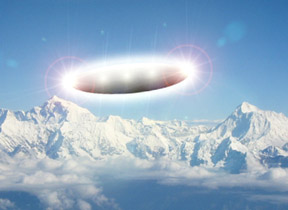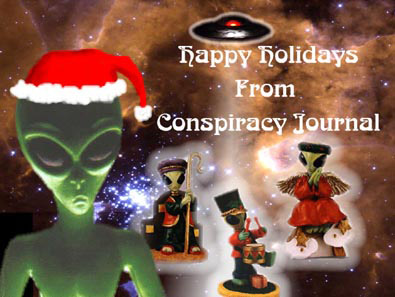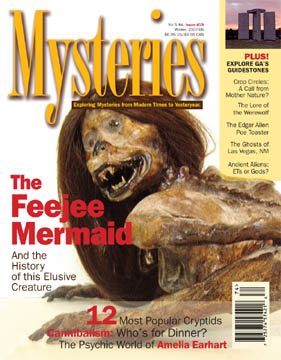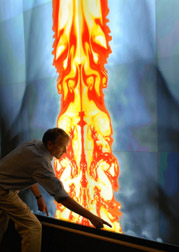- NOT QUITE DISCLOSURE DEPARTMENT -
Japan's Top Government Spokesman Says He Believes in UFOs

Yes, UFOs do exist, Japan's top
government spokesman said this week.
"Personally, I absolutely believe they exist," said Chief Cabinet Secretary Nobutaka Machimura.
He said there was no other explanation for how the Nazca Lines were drawn in the Peruvian desert. The vast, ancient drawings can really only be properly appreciated from the air, which has led some to claim they are the work of extraterrestrials.
Earlier the cabinet, responding to an opposition lawmaker's question, issued a statement saying it could not confirm any cases of unidentified flying objects.
"The government has not confirmed the existence of 'unidentified flying objects believed to have flown from outside the Earth'." The statement was formally endorsed at Tuesday's cabinet meeting.
The government issued the comment in response to a question from lawmaker Ryuji Yamane of the opposition Democratic Party, who argued Tokyo should try to confirm what UFOs are as many people have said they have witnessed them.
"This is an issue that the nation is interested in -- it is a defence issue and a confirmation operation needs to take place," Ryuji Yamane, a lawmaker from the main opposition Democratic Party who submitted the question to the cabinet, told reporters. "But the government does not even try to collect information necessary for the confirmation."
Machimura, asked about the government's view on UFOs at a regular press conference, told reporters that the government can only offer a stereotyped response.
"Personally, I definitely believe they exist," he said. But the prime minister stuck to the official view.
"I have yet to confirm (that UFOs exist)," Prime Minister Yasuo Fukuda told reporters later in the day.
Source: Agence France-Presse
http://newsinfo.inquirer.net/breakingnews/world/view_article.php?article_id=107613
"Personally, I absolutely believe they exist," said Chief Cabinet Secretary Nobutaka Machimura.
He said there was no other explanation for how the Nazca Lines were drawn in the Peruvian desert. The vast, ancient drawings can really only be properly appreciated from the air, which has led some to claim they are the work of extraterrestrials.
Earlier the cabinet, responding to an opposition lawmaker's question, issued a statement saying it could not confirm any cases of unidentified flying objects.
"The government has not confirmed the existence of 'unidentified flying objects believed to have flown from outside the Earth'." The statement was formally endorsed at Tuesday's cabinet meeting.
The government issued the comment in response to a question from lawmaker Ryuji Yamane of the opposition Democratic Party, who argued Tokyo should try to confirm what UFOs are as many people have said they have witnessed them.
"This is an issue that the nation is interested in -- it is a defence issue and a confirmation operation needs to take place," Ryuji Yamane, a lawmaker from the main opposition Democratic Party who submitted the question to the cabinet, told reporters. "But the government does not even try to collect information necessary for the confirmation."
Machimura, asked about the government's view on UFOs at a regular press conference, told reporters that the government can only offer a stereotyped response.
"Personally, I definitely believe they exist," he said. But the prime minister stuck to the official view.
"I have yet to confirm (that UFOs exist)," Prime Minister Yasuo Fukuda told reporters later in the day.
Source: Agence France-Presse
http://newsinfo.inquirer.net/breakingnews/world/view_article.php?article_id=107613
-
THE POWER OF SUGGESTION DEPARTMENT -
Mystery Death of Chinese Teenager Triggers School Panic
Mystery Death of Chinese Teenager Triggers School Panic

More than 80 teenagers from a southwest China school have been hospitalized after the mystery death of a fellow student in what a senior doctor described as a case of mass hysteria.
Zhou Yuankun, chief of the hospital where the students were treated, said Thursday's incident was caused by panic, fear and anxiety.
Zhou said most of the students were discharged from the hospital late on Thursday or Friday. Those whose parents requested further observation at the hospital, including three students with fever, were showing no abnormal symptoms and were discharged on Saturday.
The students at the No. 2 Middle School, in Dongshan town of Qilin District in Qujing City, Yunnan Province, complained of stomachaches and headaches following the mysterious death of a seventh grader on Thursday.
A 16-year-old, identified only by his surname as Liu, first suffered a headache and vomiting at 2:10 p.m. and was taken to a clinic in the town, where he died the same day.
Shortly after Liu's death, more than 80 other students complained of palpitations, stomachaches and headaches, and were sent to the Enhong Coal Miners Hospital for medical checks.
Zhou said there was a chaos in the school compound after Liu's death.
"The school canteen didn't serve dinner until 7:00 p.m. that day, so many students developed the symptoms due to low blood sugar," said Zhou.
A number of students with no symptoms were also sent to see doctors at the request of their parents.
Zhou said three of the students were later diagnosed with fevers.
An investigative group comprising personnel from the public security, health and drug control authorities was set up after Liu's death. They immediately sealed all food and dishes served at the school canteen for tests, but ruled out the possibility of food poisoning after finding nothing abnormal.
Additional tests on Liu's stomach and some bread left in his pocket, as well as an autopsy, also ruled out the possibility of a food poisoning.
However, doctors identified signs of a brain haemorrhage and further tests were begun on Friday night to establish the cause of death. The results are not yet known.
A source with the local government said the authorities reacted swiftly as local media had been running reports suggesting food poisoning following Liu's death. All the students were asked how they were feeling and those who said they felt discomfort were sent to hospital.
Chen Taoxian, a girl from the Liu's class and one of the three students diagnosed as ill, was actually suffering from flu.
"She looked pale with parched lips, complaining of difficulty sitting down when I met her at the hospital," said her mother.
Chen was treated for a heavy cold at Enhong Coal Miners' Hospital. "I felt much better after the treatment," said Chen, whowas discharged early on Saturday.
Source: China View
http://news.xinhuanet.com/english/2007-12/15/content_7256610.htm
-
HAVE A SPOOKY CHRISTMAS DEPARTMENT -
The Lost Tradition of Christmas Ghost Stories
The Lost Tradition of Christmas Ghost Stories

Ghost stories at Christmas, seems out of place or is it? We have enjoyed the classic, The Christmas Carol, and Tim Burton's The Nightmare before Christmas? In Celtic times, there were spirits ghost, and mystical beings that were associated with the fire festival.
The Winter Solstice, Alban Arthuan, or better known as Yuletime Season is a time of death and rebirth of Nature and our souls. It is said the Old Sun dies at dusk of December 21st. and when the Sun of the New Year is born at the dawn of December 22. The New Sun is thought to rejuvenate the aura of the Earth. It is like a mystical cleansing to the spirits and the souls of the dead.
Samhain is considered the most haunted time of the year in the Celtic calendar; Yule is the second. Haunting starts on December 6th to December 20th. The spirits are more active as they wait for the rebirth of the Sun’s powers.
This haunting is not the same as during Samhain, where the veil is thinned so that the dead can walk among us. The spirits of Yule are connected with the mystical and the psychic logic of the Solstice Season. However, one can be visited from their ancestors, relatives, spirit guides or their soul friends (anamchara).
A Yuletide story called the Sluagh-Sídehe of Brug na Bóinne. It translates people of the mound or barrow where the dead have been buried. All sídehe in the Celtic mythology and traditions are haunted. It is said that they are the gateway for the souls and spirits of the dead. It is also a gateway for living mortals so that they can pass back and forth to each world.
On the other side the sídehe is the Otherworld or the Land of the Youth, the Isle of the Blessed. This is where the living soul continues the quest for wisdom. The people of the Sídhe are the Faeryfolk. They live forever beyond the sídhe in the ráths, which are submerged roundhouses or Faery fortresses, which are their magical castles in the Otherworld.
The custom of the Yule Log also seems to be a dying trend. It used to be a large log, cut from ones own land or a neighbor’s, which was supposed to burn all twelve days of Christmas. While relaxing before the burning log, it was customary for people to gather around and tell ghost stories. Further proof of the existence of the tradition can be found by listening to the popular Christmas song, “It’s the Most Wonderful Time of the Year”. In it you can hear the phrase “there’ll be scary ghost stories and tales of the glories of Christmases long, long ago.”
Of course this being Conspiracy Journal, we have some true Christmas ghost stories to tell. The following weird tale took place in Liverpool, England in the early 1990s, and it has never been explained. It all started in one foggy December evening in 1991.
On the evening of Friday, December 20th, 1991, at 7 pm, the Edwards family of Dovecot decided to go and do a bit of late Christmas shopping in Liverpool city centre. Mr Edwards drove his wife and four kids to town in his old Volvo estate, and as usual, finding a place to park proved to be a real pain. Mr Edwards drove about, searching desperately for a parking space as his three sons and daughter gazed at the spectacular Christmas lights and decorations lining the streets. The youngest of the Edwards children was Abbey, who was only six years old. She loved Christmas, and for days she had been pestering her mum and dad to take her to see the big fir tree covered with coloured lights in Church Street.
As Abbey's dad was grumbling about finding a place to park the Volvo, her Mum suddenly pointed to a secluded side-street called Bold Place, which runs from Berry Street, past the back of St Luke's Church, up to Roscoe Street.
"You're a genius." Mr Edwards complimented his wife and he turned left and drove up the poorly-lit cobbled road, which was on a bit of an incline. As soon as the car was parked up, the kids eagerly jumped out the vehicle and all four of them started asking their parents what they were getting for Christmas. Meanwhile, an icy fog rolled down the street.
Mr Edwards checked the doors of the car were locked then had a quick discussion with his wife about where they were going to first. He wanted to go to a shop in Bold Street to buy his father a cardigan, but Mrs Edwards insisted upon going to Dixons first to buy a CD player for her sister. Then the children started arguing too; they wanted to go to various toy stores first. Mr Edwards shouted, "Awright, will you all just shut up!"
The family were about to walk off when Mr Edwards suddenly noticed something - and his heart skipped a beat. With a look of dread he glanced about Bold Place and muttered, "Where's Abbey?"
Everyone looked around. Mr Edwards anxiously looked through the windows of the car, but his little daughter wasn't there. "Where's she gone?" Mrs Edwards asked with a tremble in her voice. The three boys looked about, but the street was empty.
Then they all heard a faint voice scream out in the distance. "Daddy!" The voice sounded like Abbey, and it came from the top of Bold Place, towards Roscoe Street. The Edwards family rushed up the cobbled road with the father leading the way. "Abbey!" Mr Edwards shouted, "Where are you?"
The gates at the back of St Lukes were open, and Mr Edwards surmised that his daughter had wandered into the precincts of the old church. He hurried into the grounds followed closely by his wife and their sons, and once again they all heard Abbey cry out for her father. But the little girl was nowhere to be seen, and the fog was getting thicker by the minute.
Mr Edwards didn't want to alarm his wife and kids, but he wondered if some perverted lunatic had grabbed his daughter and taken her into the ruins of the old church. He handed his wife the car keys and told her to go and bring the torch from the vehicle. She did this and Mr Edwards climbed up onto the ledge of a church window and shone the flashlight into the deserted church ruins. The interior was deserted with nothing but rubble scattered about. Mr Edwards knew that the church of St Luke had been gutted by an incendiary bomb in World War Two during the Blitz. Only the shell of the building survived, and the church had been left that way as a reminder of the war. And yet it sounded as if Abbey's voice had come from inside the church.
As Mrs Edwards helped her husband down from the window, she said, "Listen!"
It was the faint eerie sounds of a church organ, and it seemed to be emanating from the church.
Mr Edwards said, "Sound can play funny tricks at night. Come on, let's go to the police."
Mrs Edwards started to cry, but her husband said, "It'll be all right. We'll find her love. She can't have gone far."
The family went to the police station in Hope Street and told the desk sergeant about their lost daughter. The sergeant alerted all the patrol cars in the area, and told officers on the city centre beat to be on the lookout for the girl. The Edwards family then rushed back to Bold Place to resume their search for the girl. They searched the grounds of St Lukes once again, and after twenty minutes, they were about to return to their car, when something happened which continues to puzzle the Edwards family to this day. A tall man wearing a top hat and a long black coat came out of the grounds of St Lukes and walking with him was little Abbey, holding his hand.
When Abbey saw her mum and dad she ran to them and started to cry as her father picked her up. The sinister man in black looked like something out of the Victorian age. He had long bushy sideburns, a pallid face, and staring ink-black eyes. He stood outside the gates of the church, and in a creepy low voice, the outdated-looking stranger said, "Please accept my sincere apology for any distress caused."
He then turned and walked silently back towards the rear of the church ruins.
Mrs Edwards grabbed Abbey from her husband and said, "Are you all right? Where have you been?"
Abbey just said, "I'm fine mummy."
Mr Edwards was furious, and he shouted after the man, "Oi! Who are you? What's your game eh?"
Then a police patrol car came tearing down the road, and Mr Edwards told the officers in the vehicle about the stranger who had returned his daughter. Three police officers bolted from the car and rushed into the grounds of the church wielding their batons.
But the police found no one. The grounds were empty. More police turned up and the grounds were searched again with powerful torches, but the place was deserted. However, several police officers also heard the faint strains of a church organ playing nearby somewhere, but they never determined just where the strange music was coming from.
One of the policemen asked little Abbey where she had been, and the child gave a strange account. She said an old woman in a shawl had grabbed her hand and dragged her into the church, where a mass was being held. In the church, there were many people dressed in old-fashioned clothes. The women wore big hats, and the men were all dressed in black. Abbey had screamed for her father, but the old woman had put her hand over the girl's mouth to silence her. Sometime later, a tall man came into the church and pulled Abbey from the old woman's clutches. He had been the man who had taken Abbey back to her parents.
The intrigued policeman continued to interrogate the child, and he asked her if the man had spoken to her about the strange incident. Abbey shook her head, then said, "The man said he had been a long time dead, that's all."
A cold shudder ran up everyone's spine when they heard the child's reply. Since that strange incident, the Edwards family refuse to go anywhere near St Luke's Church, especially during the Christmas period...
(This story reproduced with permission from Tom Slemen)
Another ghostly tale comes from Alle G: Around Christmas time, 2001, I had a few weird experiences involving a spirit that must still live in our house. One of the past owners, a lady, died in our house. Around Christmas time, I felt the presence more and a lot stronger than I usually did.
One night, I decided to draw whatever my hand felt like drawing. I drew a bottle with ribbons exploding out of it, then a yacht... then it felt like someone was moving my hand for me. My hand drew a circular shape that at first looked like a peach. My hand lifted and dropped and made a mark inside the circle. My hand lifted again and dropped and it made a weird curve. My hand drew another dot. I regained full control over my hand again and I looked at what I had a drawn: a weird smiley face.
I told my mum about it and she said to try it again the next night, and so I did. I was painting some landscapes in water colours when I felt the presence again. My mum had said that she thought her name was Faye, so that name was stuck in my mind.
I asked, "What is your name?" and I let my hand be controlled. I wrote what looked like the name Faye. I asked what the last name was. I wrote something that looked like "Edith." This was all confusing. I asked why it was here, and the reply looked like "I'm lost." I asked why it was here with me, and the reply looked kind of like "crussby," but was still very hard to read. I asked, "What?" and the answer cleared up a bit, but still not a real word. I asked again, and the final reply came what looked like "crusty." I am still puzzled, but the spirit may have meant the house was crusty since it is falling to bits in some areas.
Later on, my mum confirmed that the lady's name was Edith. This freaked me out big time, and I still felt the presence strongly for a while until a few days after Christmas.
Bonnie O. tells about a Christmas phone call from heaven when her mother passed away three years ago: We were very close and I miss her daily. Last Christmas evening, I went to bed and woke up to the phone ringing. I answered it and a voice that was very familiar to me said, "Hello there." It was my mother's voice. The line had a static noise and it sounded to cut in and out. I said, "This can't be you, mom. You're dead." She said, "Oh, come on now." She sounded a bit agitated, and then we were cut off. My 16-year-old daughter was sleeping in the next room and also heard the phone ring that night. I know it was my mother's voice: she has a Norwegian accent and it was her!
Happy
Holidays from your friends at Conspiracy Journal!








